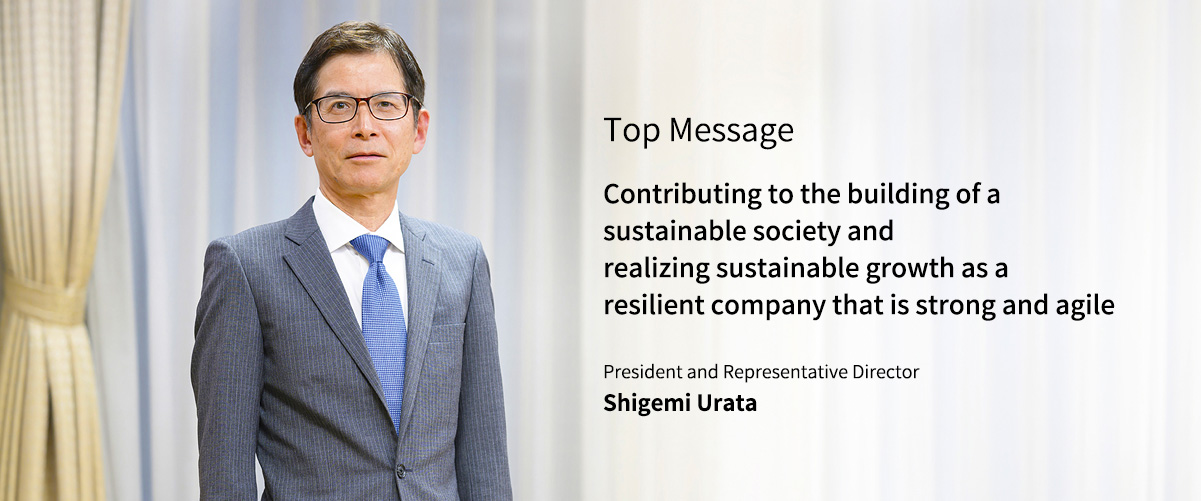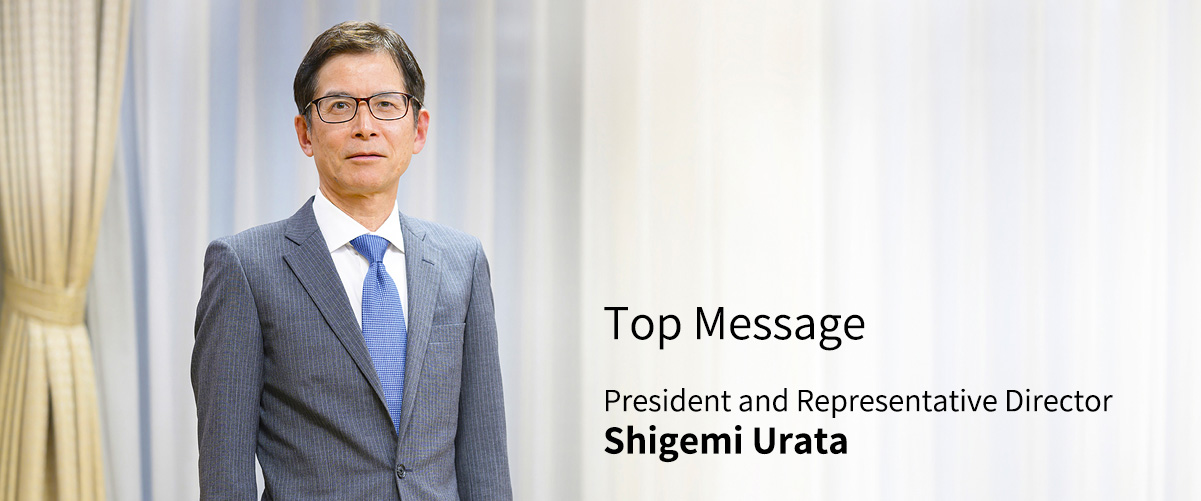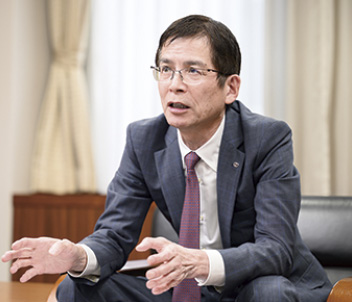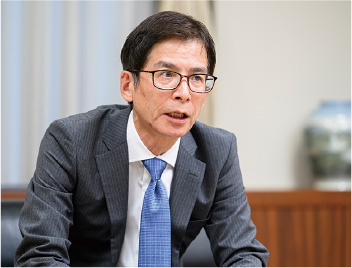

A century-old spirit of production as a springboard to addressing greater challenges for the next century
The stainless steel and high-performance alloys that are currently our mainstay products are used not only for general consumer goods but also as part of social infrastructure, such as structures and production facilities, and continue to provide value over the long term because of their excellent functionality as well as high recyclability and long product lives. In an age when both companies and products are expected to be sustainable, I believe that the mission of our management is to continue to take on the challenge of creating new products and value that people and society demand for the next 100 years.
Capturing the changing business environment and strengthening competitiveness
The business environment we face remains highly uncertain. A complex set of external factors is affecting our business activities, including soaring resource and energy prices, including sharp fluctuations in the price of nickel, as well as geopolitical risks, labor shortages in Japan due to the declining birthrate and aging population, and exchange rate fluctuations and tightening international regulations.
In this environment, our results for FY2025 resulted in lower revenues and profits compared to FY2024. The decrease in profit was due to lower selling prices as the price of nickel, a core raw material, switched to a downtrend, and due to the product mix, including a decline in demand for products in high-performance alloys. Although sales volumes of both general stainless steels and high-performance alloys increased, they did not reach the targets set at the beginning of the fiscal year.
In addition, one of the factors that affected our performance was the changing environment in our major markets, especially in China, which requires a flexible and rapid response. In the Chinese market, demand for stainless steel is declining due to economic stagnation. Furthermore, the sales volume of high nickel heat-resistant alloys declined due to delays in solar-related projects and other factors, which had a major impact on us, given that the high-performance alloy field to China accounts for approximately 40% of our overseas sales. To address this situation, we will continue to expand into other fields and develop overseas markets outside of China.
Moreover, the stagnant Chinese economy has led to more low-cost general stainless steel produced in China being exported to Japan, putting pressure on the domestic market. As a measure against it, we are working to differentiate ourselves in areas other than pricing by ensuring reliable delivery times and quality, offering better after-sales services, and increasing the ratio of niche steel grades and items that are difficult to replace with imported materials. Furthermore, we are working to build sustainable business relationships by gaining customer understanding of appropriate pricing. In many conversations of mine with our customers since serving at the Corporate Marketing Division, I have realized that our strength is the consistent improvement of our meticulous sales and delivery system and our ability to make proposals that meet niche needs through close communication with a wide variety of customers. We intend to continue providing this value going forward.
Meanwhile, with regard to the U.S. market, we are closely monitoring movement in tariff policy. Sales ratio to the U.S. account for about 2% of total sales, so the direct impact is not significant. However, sales volume to some customers has already been affected, and the future outlook is difficult to predict. Furthermore, since some products processed at our sales destinations are exported to the U.S., we must continue to be vigilant in dealing with demand fluctuations, including those in other regions. Note that U.S. tariff policies are not exclusively negative for us. If U.S.producers, who are our competitors, also have to pay tariffs on raw material imports, their costs may increase. This means that our relative competitiveness against them will increase in markets outside the U.S. In light of the slowdown in the Chinese economy, we intend to take advantage of this opportunity to expand our market to more diverse countries and regions going forward.
Steadily implementing core measures in the Medium-Term Management Plan
Given this business environment, we are steadily expanding sales of high-performance alloys as set forth in Basic Strategy [1] of our Medium-Term Management Plan 2024 (April 1, 2023–March 31, 2026). Although China is in an adjustment phase with an economic slowdown and financial instability, the fact remains that it is a huge market. We will continue to strengthen sales of high-performance alloys in anticipation of rising demand in the oil and gas sector, future expansion in hydrogen-related fields, and a future recovery in solar-related demand. However, in the interests of future growth and risk diversification, we will not focus solely on the Chinese market, but will also strengthen efforts to expand sales of high-performance alloys in India, an area of remarkable economic growth, and in neighboring regions such as the Middle East, using India as a foothold.
As part of this effort, we opened a local subsidiary in India in August 2025. India is appealing in that it is the country with the world’s largest population, which is expected to lead to increased investment in infrastructure development and energy-related projects due to growing domestic demand. In addition, we are geographically closer to this market than our competitors in Europe and the U.S., giving us an advantage in terms of delivery time. In fact, for environmental and energy-related applications in the Middle East and demand for flue gas desulfurization equipment has been strong.
I myself have experience with sales activities in India; this is an area where you must be tough in negotiations. Business meetings are often protracted, and there are limits to what can be accomplished solely on business trips. Therefore, it is very important to establish a local base and build relationships of trust through repeated presentations and proposals while taking the other party’s point of view into consideration. With the establishment of this local subsidiary, we will strive to capture further demand through such dialogue.
As a growth area, we are focusing on hydrogen infrastructure. Materials used in a hydrogen environment require test values obtained under various conditions. Though we currently outsource testing, to enable us to accumulate expertise internally, we are in the process of implementing a materials evaluation testing facility in a hydrogen environment on the Kawasaki Plant premises, scheduled for completion by the end of March 2026.
With respect to strengthening our production framework as stated in Basic Strategy [2], a new cold rolling mill equipped with state-of-the-art technology went into full-scale operation in December 2024. Until that time, the production efficiency of our cold rolling process has declined with growing numbers of high-performance alloys, products with thin sheets, and other products with high manufacturing loads. However, this equipment eliminates these problems and improve quality, production speed, and safety. The work environment has also been dramatically improved by increasing the collection capacity of oil fumes generated during rolling, leading to easier work and greater retention for employees.
The carbonless nickel smelting initiative at the Oheyama Plant is also making steady progress. This is an initiative to break away from the conventional smelting method of mainly using imported nickel ore and coal, and to utilize recycled raw materials and renewable energy, with the goal of reducing CO2 emissions intensity of the Oheyama Plant by 70% in FY2031 compared to FY2014. Since diversification of recycled raw materials is an important measure that will directly lead to greater competitiveness, such as improvement of energy intensity and reduction of procurement costs, we are currently conducting tests to gain knowledge on about 200 types of recycled raw materials in cooperation with technical staff at production sites and our research division. Since the rotary kiln that smelts ferronickel* is in constant, 24-hour operation, we continue to conduct large-scale tests several times a year using the actual equipment when it is idle. Through these efforts, the usage rate of recycled raw materials reached 58.3% in FY2025. Furthermore, in July of 2025, work was completed to convert the kiln’s fuel from coal to LNG and renewable fuels, and operations with the new fuel began in August.
Building a workplace empowering and supporting the growth of diverse human resources
Human resources are the most important management capital for sustainable growth. How to enhance human resource capabilities is an unending topic of importance for companies, and we are committed to hiring and training diverse human resources with a view to sustainable growth of our business. One of the themes we are focusing on is the utilization of diverse human resources, including women’s empowerment. In order to make competitive proposals and adapt flexibly in a rapidly changing business environment, it is necessary to have multifaceted perspectives and generate new ideas and concepts. Therefore, we have set a goal of increasing the percentage of women hired in career-track positions to at least 20%, and we are working to hire and train women under this goal. We also have an urgent need to expand our global human resources who will be responsible for expanding sales of high-performance alloys overseas, and we are actively recruiting, including mid-career professionals.
In addition, it is necessary to create an environment in which the talent we recruit are motivated and can grow while demonstrating their full potential. Our new Human Resource Management System, which took effect from FY2024, was established with these issues in mind, aiming for merit-based promotions regardless of seniority, and rewarding employees based on fair and transparent evaluations. We will also conduct a survey of employees, who are responsible for carrying our organization forward, to understand the current situation, visualize and share organizational issues, and utilize the results in a new institutional design to improve employee satisfaction.
Stronger governance for faster and higher-quality decision-making
In June 2025, the Company transitioned to become a company with an Audit and Supervisory Committee in the interest of stronger corporate governance.
This has strengthened the supervisory function of the Board of Directors and enabled faster decision-making with respect to corporate management under the appropriate supervision of the Audit & Supervisory Committee.
Going forward, certain authority will be delegated from the Board of Directors to the executive side, and we will enhance deliberations at the Board of Directors regarding management plans and strategies.
Therefore, over the past year, I have had a series of open discussions with our production, research, and other divisions, on themes such as which challenges we want to and should take on, what strengths and challenges we have and face, and what kind of company we want to be. Incorporating feedback from the field and advice from outside directors, we will reassess our business environment and the Company’s strengths and weaknesses on the three-year, five-year, ten-year timeframe and beyond, identify key issues, and develop specific strategies and measures to address each.
As I envision the future, my own desire is to make Nippon Yakin Kogyo the global leader in high-performance alloys. To do so, we must be willing to compete not only with existing competitors, but also with new entrants such as those from China and India, taking our fight to the global stage. Competition is fierce and not for the faint of heart. However, it is my strong hope that we can prevail with a competitive mindset only gained by throwing ourselves into such a battlefield, and that we can emerge with greater strength than before.
As President, I believe my most important mission is to inspire our employees—who are known for their diligence, integrity, and strong sense of responsibility—through continuous dialogue, cultivating a spirit of challenge needed to engage in the fiercely competitive global market. I would like to taking on challenges with the entire company, including sales, production, research, and purchasing, to work together as one.
On the occasion of our 100th anniversary, it is my promise that we will continue to strengthen relationships with our stakeholders and aim to enhance our corporate value in coexistence and harmony with society and the global environment. As we move toward the next 100 years, we will strive to create a company in which we, the current generation, and the next generation of employees can be proud to work. I offer my sincerest thanks to all stakeholders for their continued understanding and support of our endeavors.
* An umbrella term for alloys of iron and nickel that are used as intermediate materials for iron and steel products

